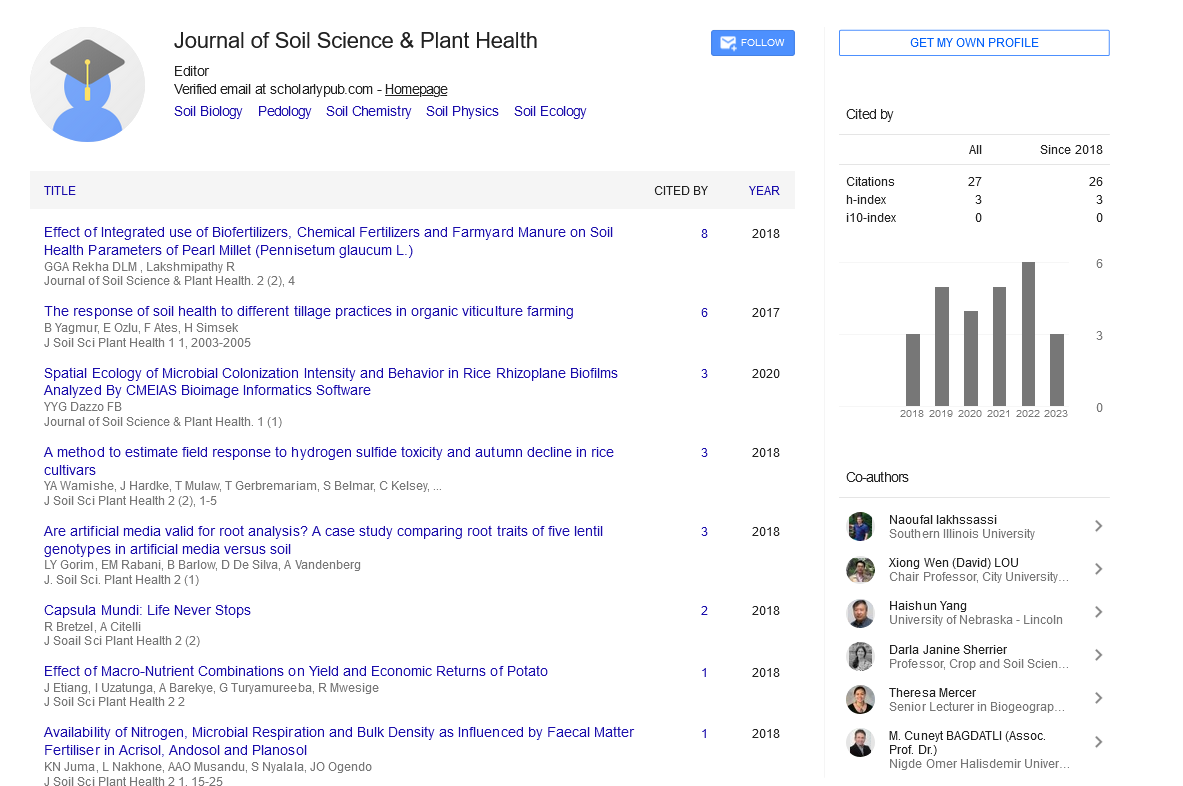Commentary, J Soil Sci Plant Health Vol: 8 Issue: 1
Soil Microbiome Dynamics in Agroecosystems
Han Joon*
Department of Bioinformatics and Systems Biology, Huazhong University of Science and Technology, Wuhan, China
- *Corresponding Author:
- Han Joon
Department of Bioinformatics and Systems Biology,
Huazhong University of Science and Technology,
Wuhan,
China
E-mail: hanjoon123@gmail.com
Received date: 27 October, 2023, Manuscript No. JSPH-23-118465;
Editor assigned date: 30 October, 2023, PreQC No. JSPH-23-118465 (PQ);
Reviewed date: 13 November, 2023, QC No. JSPH-23-118465;
Revised date: 05 January, 2024, Manuscript No. JSPH-23-118465 (R);
Published date: 12 January, 2024, DOI: 10.4172/jsph.1000213
Citation: Joon H (2024) Soil Microbiome Dynamics in Agroecosystems. J Soil Sci Plant Health J 8:1.
Description
Agroecosystems, where agriculture is practiced, represent an intricate interplay of biotic and abiotic factors. At the heart of these systems lies the soil microbiome, a diverse community of microorganisms that inhabit the soil and profoundly influence its health and productivity. The soil microbiome, composed of bacteria, fungi, archaea, and other microorganisms, plays a pivotal role in regulating various soil processes. This manuscript explores the dynamics of the soil microbiome in agroecosystems, emphasizing its impact on soil health, nutrient cycling, and plant growth.
The soil microbiome is a complex and diverse ecosystem that teems with microscopic life. It includes a wide array of microorganisms, each with its unique role in the soil environment. These microorganisms interact with one another and with plants, influencing the overall health and fertility of the soil. Intriguingly, some of these microscopic inhabitants are unsung heroes in the battle against plant diseases. They wage warfare against pathogenic invaders, guarding our crops and reducing the need for chemical pesticides. In short, the soil microbiome is not only our silent support system but a bustling, vibrant community essential to the very foundation of agriculture.
The soil microbiome carries out several essential functions within agroecosystems:
Nutrient cycling: Microorganisms are key players in the cycling of essential nutrients, such as nitrogen, phosphorus, and sulfur. They decompose organic matter and transform it into plant-available nutrients.
Decomposition: Microbes break down organic matter, including dead plant material and organic inputs, enhancing soil structure and releasing nutrients.
Pathogen suppression: Some microorganisms have antagonistic interactions with plant pathogens, contributing to disease suppression in the soil.
Symbiotic relationships: Beneficial mycorrhizal fungi form symbiotic relationships with plant roots, aiding in nutrient uptake. Nitrogenfixing bacteria help convert atmospheric nitrogen into a plant-usable form.
The composition and activities of the soil microbiome are dynamic and subject to various factors:
Microbial communities in the soil fluctuate with changing seasons. The availability of resources, temperature, and moisture levels influence these seasonal dynamics.
Different land use practices, such as conventional tillage, no-till farming, crop rotation, and agrochemical use, significantly impact the composition and diversity of soil microbial communities.
Plants release exudates into the soil, shaping the composition of microbial communities around their roots. This, in turn, affects nutrient acquisition and plant health.
Understanding soil microbiome dynamics has profound implications for agroecosystem management:
Enhanced nutrient management: By understanding the role of microorganisms in nutrient cycling, agroecosystems can optimize nutrient management strategies, reducing the environmental impact of fertilizers.
Knowledge of microbial communities involved in disease suppression can inform strategies for biological disease control, reducing the need for chemical pesticides.
Monitoring soil microbial communities can serve as a valuable indicator of soil health. This assessment can help farmers and land managers make informed decisions about soil conservation and sustainable land use.
Restoring ecosystem services: Agroecosystem practices that promote microbial diversity and activities can enhance the provision of ecosystem services, including soil fertility, water retention, and carbon sequestration.
As research on the soil microbiome advances, several challenges and future directions become evident:
Microbial "dark matter": A significant portion of soil microorganisms remains uncultivated and uncharacterized. Unraveling the mysteries of this microbial "dark matter" is a key challenge.
Effective collaboration among soil scientists, microbiologists, agronomists, and ecologists is essential for translating research findings into practical agroecosystem management.
The impact of climate change on soil microbiome dynamics is an emerging area of research. Understanding how shifts in temperature and precipitation patterns affect microbial communities is crucial for adapting agroecosystems to a changing climate.
Conclusion
The soil microbiome is an intricate and dynamic ecosystem that underpins the functioning of agroecosystems. Its influence on nutrient cycling, disease suppression, and plant health is critical for sustainable and productive agriculture. As research in this field continues to evolve, a deeper understanding of soil microbiome dynamics will shape the future of agroecosystem management, promoting both environmental sustainability and food security.
 Spanish
Spanish  Chinese
Chinese  Russian
Russian  German
German  French
French  Japanese
Japanese  Portuguese
Portuguese  Hindi
Hindi 